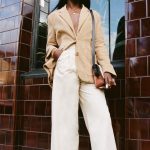It feels like we’re living in one long documentary about the end of the world right now, and yet still nothing brings me more peace than falling asleep listening to lies, betrayal and murder. I’m not alone – demand for true crime content reached an all-time high on Google in 2020 and continues to rise steadily across all social platforms. From Tiger King to I’ll Be Gone in the Dark, there has been a feeding frenzy of the genre over the course of the pandemic. But forget the Netflix deep-dives and podcasts for a second. The most popular true crime format of 2020? Makeup and murder.
What sounds slightly twisted isn’t anything new. YouTubers have been blending out their contour to the tune of a serial killer’s modus operandi for a while. One of the OG makeup murderinos, Bailey Sarian, got started in 2019 when she realised her discussion of the infamous Chris Watts case while applying her makeup drew in significantly more views than her usual output of tutorials and GRWM videos. She’s since gone on to almost entirely refocus her channel on her “Murder, Mystery and Makeup” series and is particularly interested in cannibalism. Big names such as Bella Fiori, Eleanor Neale and Savannah Brymer also saw their followings explode after combining their beauty and true crime content. Even YouTube itself has noted that a vast portion of true crime viewers and creators alike migrated from the beauty community.
Over the course of 2020, the line between the two genres became even more blurred. Those who had never publicly shared their passion for true crime came out of the shadows — earlier this month, makeup guru Gina Box announced plans to launch a new YouTube channel dedicated to her favourite stories, while journalist Pandora Sykes pivoted from lifestyle to cold cases with her new podcast series, The Missing. Meanwhile, lifestyle influencers like Zoe Sugg have promoted Sky boxsets by professing their love for grisly documentaries and beauty TikTokkers started using sound bites of famous cases as soundtracks for 60-second tutorials. Nearly 500 makeup looks were set to the tale of how the Golden State Killer used town hall meetings to gauge how he could best terrorise his victims, while others went a step further and made the real life people involved in the stories the inspiration of the looks themselves. Some transformed themselves into a victim of the Zodiac Killer, Ted Bundy’s fictional sister, or the Black Dahlia. Debates over Jon Benet Ramsay’s fate were nearly as commonplace in beauty tutorials as Doja Cat songs.
In short, TikTok did what TikTok does best and commodified a digital trend into something short, snappy and shareable. But in doing so, it did what our growing obsession with true crime has been threatening to do for years and crossed over into uncomfortable and, in some cases, downright gross territory. True crime addicts have long been plagued with criticism of exploitative voyeurism and in this case, they might have a point. There’s something that doesn’t quite sit right about the worst tragedy of someone’s life being poured over while someone puts on their makeup.
But don’t dismiss murder and makeup just yet. At its YouTube origins, this method of storytelling has created a community that’s nearly entirely female. Women have always dominated the genre – according to Amazon, 70% of true crime books are purchased by women, and they make up over 60% of true crime viewers on YouTube. Experts suggest this is partly due to the idea that, as more common victims of crime, it helps us feel more prepared and tackle our fears in a safe environment.
You may also like
Safety is where the makeup comes in. Hearing horrifying tales over the top of something as methodical and grounding as a beauty routine has a similarly soothing impact as watching ASMR. Viewers aren’t looking to be desensitised to the details of the crimes, but rather to understand the who, what, when and why without actually experiencing the trauma itself. Traditionally a lot of content in the genre has been made for men, ignoring the victims and glamorising the killers (just think how much Ted Bundy would have loved the casting of Zac Efron in his 2019 biopic) but this is a space made by women, for women.
Blending beauty and true crime is unorthodox and, done wrong, can be incredibly toxic. It shouldn’t be a way to make beauty content edgier or used with the same consideration as you would when deciding if a song has been overplayed in makeup tutorials. However, at its heart, it’s just a new way of serving true crime’s core audience.
By Chloe James, fashion and beauty editor of CORQ. Picture credit: Bailey Sarian via Instagram.










#MeToo movement aided R. Kelly’s conviction and gave Black women long overdue step towards justice